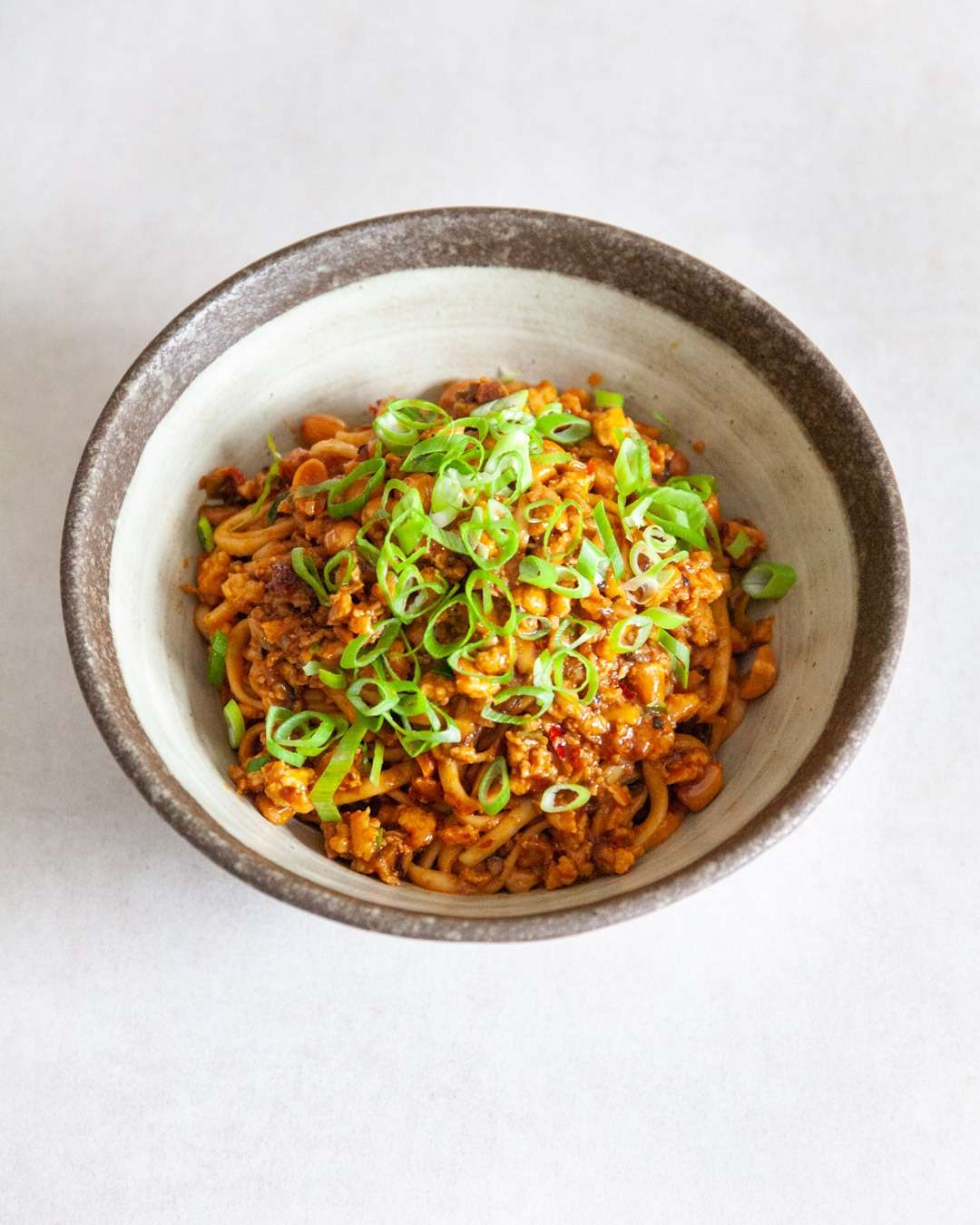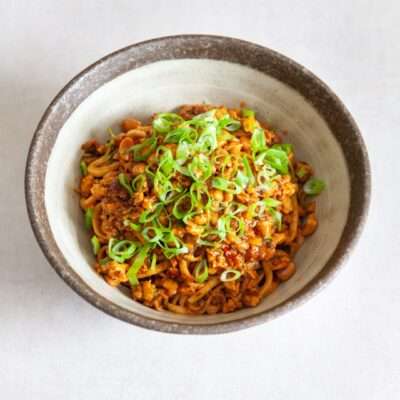Chilli Bean Noodles

There are a few condiments that have become immensely popular due to their versatility in the kitchen (I’m looking at you, miso and gochujang). Yet very excitingly, many other creations have not yet been discovered far beyond their native grounds, but have long been hailed for their ability to enrich everyday dishes. Doubanjiang is one of those power foods.
Doubanjiang (豆瓣醬) is a savoury paste made from fermented broad beans, Erjingtiao chillis, salt and wheat flour and is such a fundamental element of Sichuan cooking that it is often referred to as the ‘soul of Sichuan cuisine’.
The most famous and widely used variety is Pixian doubanjiang, a geographically protected product due to the ideal climate conditions in the county of Pi. To make the paste, the broad beans are left to grow a mould called Qū (曲), before they are fermented and mixed together with the chillis, wheat flour and salt and fermented even further for up to 3 years (and sometimes longer). It is known for its use in dishes like mapo tofu and kung pao chicken, but in this recipe, we’re spicing up a simple Sichuan-inspired noodle sauce for an easy way to try out the paste.
Where to buy Doubanjiang
Although it is such a common ingredient in Sichuan cooking, I struggled to find it in my local Chinese stores and eventually sourced it from the well-stocked Sous Chef.
Health Benefits
Aside from its culinary uses, doubanjiang is also believed to have health benefits, such as aiding digestion and boosting the immune system, thanks to the fermentation process that creates beneficial bacteria.
serves 2
Ingredients
-
50g raw or roasted peanuts
-
1 tbsp Broad Bean Paste Doubanjiang (40g)
-
250g firm tofu
-
125g shiitake mushrooms
-
4 spring onions
-
1/2 tbsp Chinese sesame paste or tahini (20g)
-
1 tsp soy sauce
-
2 tbsp chilli oil & 1 tsp sediment
-
1 tsp golden granulated sugar
-
3 garlic cloves
-
20g ginger
-
200 ml water or veg stock
-
200g Chinese-style noodles of your choice
Method
If using raw peanuts, add them to a tray and roast them at 180°C for 15 minutes or until golden. Set aside.
Heat some oil in a large frying pan and stir-fry the chilli bean paste until the oil is bright red and the paste smells aromatic. Transfer it to a mixing bowl.
Squeeze the tofu between sheets of kitchen paper to remove as much water as possible. Then use your fingers to crumble it into a small mince. Heat some more oil in the same frying pan you used before, then fry the minced tofu on medium-high heat until golden and set aside. Finely chop the mushrooms and fry them in oil until golden and set aside as well. Slice the spring onions and set aside for later. Bring a pan of seasoned water to a boil for the noodles.
In the meantime, you can finish the paste. To the mixing bowl with the chilli bean paste, add the sesame paste or tahini, soy sauce, chilli oil, chilli sediment and sugar. Grate in the garlic and ginger and mix it into a paste, then add the water or veg stock and stir to combine. Heat up the frying pan once more and pour in the sauce. Let it come to a boil, then turn off the heat and stir in most of the spring onions followed by the tofu, mushrooms and peanuts.
Cook the noodles according to the packaging instructions, then add to the pan and stir to mix well. Divide everything over two bowls or deep plates and garnish with the remaining spring onions.

Chilli Bean Noodles
Ingredients
- 50 g raw or roasted peanuts
- 1 tbsp Broad Bean Paste Doubanjiang 40g
- 250 g firm tofu
- 125 g shiitake mushrooms
- 4 spring onions
- 1/2 tbsp Chinese sesame paste or tahini 20g
- 1 tsp soy sauce
- 2 tbsp chilli oil & 1 tsp sediment I used Gulp
- 1 tsp golden granulated sugar
- 3 garlic cloves
- 20 g ginger
- 200 ml water or veg stock
- 200 g Chinese-style noodles of your choice
Instructions
- If using raw peanuts, add them to a tray and roast them at 180°C for 15 minutes or until golden. Set aside.
- Heat some oil in a large frying pan and stir-fry the chilli bean paste until the oil is bright red and the paste smells aromatic. Transfer it to a mixing bowl.
- Squeeze the tofu between sheets of kitchen paper to remove as much water as possible. Then use your fingers to crumble it into a small mince. Heat some more oil in the same frying pan you used before, then fry the minced tofu on medium-high heat until golden and set aside. Finely chop the mushrooms and fry them in oil until golden and set aside as well. Slice the spring onions and set aside for later. Bring a pan of seasoned water to a boil for the noodles.
- In the meantime, you can finish the paste. To the mixing bowl with the chilli bean paste, add the sesame paste or tahini, soy sauce, chilli oil, chilli sediment and sugar. Grate in the garlic and ginger and mix it into a paste, then add the water or veg stock and stir to combine. Heat up the frying pan once more and pour in the sauce. Let it come to a boil, then turn off the heat and stir in most of the spring onions followed by the tofu, mushrooms and peanuts.
- Cook the noodles according to the packaging instructions, then add to the pan and stir to mix well. Divide everything over two bowls or deep plates and garnish with the remaining spring onions.

This is a great recipe, just made it and enjoying very much. And you are so right about other condiments taking the limelight. Doubanjiang is a fabulous ingredient, discovered it a while back and always have some in the kitchen…WUNDERBAR
Wonderful! Yes, it’s such an underrated condiment! Thanks for giving the recipe a go!
Bean thread noodles are incredibly versatile and can be prepared in many delicious ways. For a step-by-step guide to making a flavorful bean thread noodle dish, check out this recipe – https://www.simplerecipebox.com/bean-thread-noodle-recipe/.
The recipe includes mung bean jelly noodles, garlic, soy sauce, and more, offering a delightful culinary adventure.